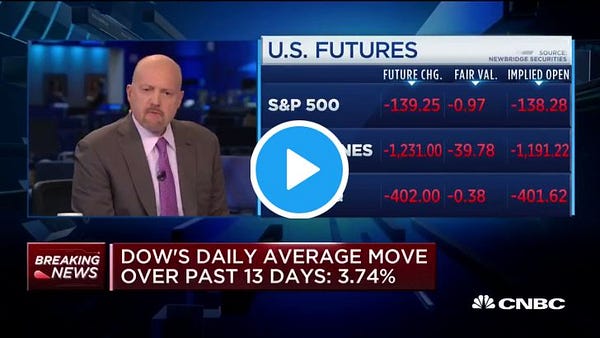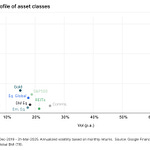This installment of Off The Chain is free for everyone. I send this email to our investors daily. If you would also like to receive it every morning, join the 40,000 other investors today.
To investors,
Yesterday was an absolute bloodbath across markets. It feels like I am writing that almost every day now. There is not a person participating in financial markets that doesn’t have a pit in their stomach. This feeling can only be described one way — it sucks. Prices keep falling and falling. There is no end in sight. We all know that every asset is not going to zero, but the uncertainty of it all can be overwhelming to some.
There is one main difference between all these market drops though. Every financial market in the world except one has hours of operation and structural mechanisms to prevent high levels of volatility. Take the US stock market for example. It trades from 930am to 4p EST every day. If stocks ever fall 7% in a single day, trading is halted for 15 minutes. If they proceed to fall 13% in a day, trading is halted again. And god forbid they fall 20% in a single day, trading is over for the day. Why does the market operate this way? Those in power believe it is the best way to protect investors.
But this is not how free market capitalism works. Take the Bitcoin market as a comparison. There are no hours of operation. Bitcoin trades 24/7/365 on a global basis. The market can go up as much as it wants and it can go down as much as it wants. Circuit breakers are non-existent. For example, Bitcoin literally dropped more than 50% at one point yesterday, before rallying back significantly to end the day only down approximately 30%.

That is a level of volatility that most traditional investors couldn’t stomach. They are too used to the non-volatile, traditional asset markets. But the current liquidity crisis is screwing up that level of comfort. We are watching the traditional investors get uncomfortable really fast. Yesterday, the S&P 500 was down 9.5% for the day. If you look at historical volatility levels, this would be the equivalent of Bitcoin dropping 51%. The difference is that Bitcoiners are used to the volatility, while the stock investors are acting like the world is ending.
Additionally, the S&P fell 9.5% even though (a) the circuit breakers went off after the initial 7% fall upon the opening of the market and (b) the Fed announced a monetary stimulus plan that totaled more than $1.5 trillion. Yes, you read that right. The S&P 500 was as volatile as Bitcoin’s 51% price drop on a relative basis, yet this all happened in spite of the market structure mechanisms that have been put in place. Most traditional investors will argue that those market structure mechanisms are net positives, but I would argue the exact opposite.
The stock market is full of fragile assets. They can’t withstand volatility or pressure. The investors are soft. They don’t know what true free markets look like anymore. Whenever something bad starts to happen, they just start yelling for the Fed to come in and bail them all out. This isn’t capitalism, this is a form of socialism. The rich people just don’t like to use that word when they’re the ones doing the begging for help. Why should majority of Americans pay for the misdeeds and bad decision making of the investors who keep buying the stock market equivalent of shitcoins?! Short answer — they shouldn’t.
But this isn’t just my opinion though. In a weird new development, the market is starting to call the bluff of the Fed. When the Federal Reserve announced $1+ trillion in monetary stimulus yesterday, the stock market recovered about 200 basis points for a few minutes before puking even lower.


Simply, the market doesn’t believe that the monetary stimulus will work. We already know that the market has priced in a near 100% chance that the Fed will cut rates at the next rate decision and most people believe an eventual 0% interest rate is a foregone conclusion at this point. This leaves the big decisions on the quantitative easing side — how much money can the Fed print?
The short answer is that the Fed can print as much money as they want. It is literally backed by nothing other than the belief of people. If the market is unresponsive to $1.5 trillion in stimulus, this may be a sign that the Fed will have to print trillions of dollars. Yup, I wrote trillion with an “s” on the end. Absolutely insane.
Remember, economies are like crack addicts. The crack addict was once sober. Then they tried a little bit of crack and got high. They liked it. So they do it again. And again. And again. Each time they try to get high, it takes a little more crack. At some point, the crack user becomes a full-fledged addict and needs incredible amounts of crack to get the same high.
This is how economies become dependent on monetary stimulus too. They were once void of it. Then they tried a little bit of stimulus and it worked. They liked it. So they did it again. And again. And again. Every time they did it, they had to do a little bit more because the market was already “addicted” to the stimulus. We have now reached the point where the legacy financial system has become a full-fledged monetary stimulus addict.
This is why yesterday’s announcement probably didn’t have an effect. It wasn’t enough stimulus. The stimulus addicts needed more to get their high. As you can expect, this is a very scary world to be living in. The Federal Reserve will have to print so much money to get the market to respond that they actually risk high inflation at minimum and full-on hyper-inflation at a maximum.
Bitcoin was built for this scenario. While all the nonsense and wealthy socialism is going on in the traditional markets, the decentralized digital currency will keep doing exactly what it is supposed to do. Block after block after block being produced. The strongest computing network in the world continues to march on.
The liquid markets for Bitcoin will keep doing what they are designed to do as well. Trading 24/7/365. No circuit breakers. No government intervention. No socialism. Just a global, free market where anyone can come to buy or sell the hardest money the world has ever seen. Most people on Wall Street don’t understand the importance of this. They are too indoctrinated in the legacy system. They were literally begging for the Fed to pump billions or trillions of dollars into the system on national television yesterday!


But all is not lost. There are a small few from the old world that get Bitcoin. They understand why the world needs this asset to be the parachute from the chaos. Take Dan Tapiero for example. He has spent decades in the traditional financial system and is widely respected by many people across the global macro investing world. He tweeted this last night:


Dan gets it. Eventually more will too. On a historical volatility basis, both Bitcoin and the S&P 500 had the same volatility yesterday. The difference is that one market is heavily manipulated by the Fed and one is a completely free market. You can choose which system you prefer, but I am uncomfortable putting my wealth in the hands of those who can (a) shut down the market, (b) devalue my currency on a whim by printing trillions of dollars, and (c) have a history of lying to the American people about what they are doing and why.
Bitcoin is the most anti-fragile asset in the world. It has withstood multiple drops of over 40% in its lifetime. It is attacked every day. And yet it keeps doing exactly what it was built to do. That same resiliency can’t be used to describe the traditional markets. The stock market is full of zombie companies that don’t have enough EBITDA to service their debt. The stock prices are being propped up by a debt-fueled buy-back program that was illegal and considered market manipulation until the early 1980s.
The legacy system is rigged against the little guy. The elites are simply playing a game to enrich themselves. You have never seen them print $1.5 trillion to help the homeless, cure a disease, or solve real problems. They do it when asset prices are starting to drop though. They do it when their personal net worths are falling. And they do it at the expense of the average American.

This all started in 1971 when the link between the dollar and gold was destroyed. Since then, the distribution of wealth has not only reversed, but the wealth inequality gap continues to widen. This is what happens when you move from sound money principles to a world where those in charge can print money at will, which is then used to prop up asset prices.
Unfortunately, 50% or more of Americans can’t afford an emergency $400 bill. They live paycheck to paycheck. The monetary stimulus doesn’t bail them out. It bails out the sophisticated investors who were so drunk on chasing profits that they continued to allocate capital to over-leveraged companies and bad risk-reward trade-offs. That is what investing is all about — take risk to earn a return. But in the legacy financial system, the idea of risk has drastically changed.
The market will close if things become too risky. The Fed will step in to save you. But we all know this isn’t sustainable. Yesterday we saw for the first time that the market may be starting to understand that as well. They announced $1.5 trillion in monetary stimulus and still ended the day down 9.5%. There will be plenty of people who yell “but look at today’s performance!,” but that misses the point (this is being posted before market opening too). A single day rally in prices doesn’t fix the underlying issues.
We must stop fearing the failure of businesses or markets. The free market must reign supreme. If Wall Street doesn’t allow that to happen, the average person will go find it somewhere else. If it wasn’t so sad, it would have been hilarious watching all these wealthy “capitalists” begging for Fed intervention yesterday.
The real capitalism is happening on the free markets of Bitcoin. The decentralized, digital currency allows anyone to live and die by the decisions they make. And I, for one, am so glad that we have this escape route as an option during this upcoming financial crisis. I’ll leave you with this hilarious tweet from my friend Josh Brown:
While it made me laugh, it also shows the difference in mindset between market participants. Bitcoin doesn’t need the Fed to ask. It is the best performing asset of the last decade and it is still up more than 25% from where it was trading on this day last year. Bitcoin’s volatility is a feature, not a bug. Those who are willing to stomach the pain on the downside are the ones who earn the right to reap the rewards on the upside.
-Pomp
If you enjoyed reading this piece, you can subscribe to get my analysis every morning. There are 40,000 other investors who read about finance, macroeconomics, business, technology, and Bitcoin every day. Hope you join us!
THE RUNDOWN:
New York Regulator Tells Crypto Firms to Develop Coronavirus Contingency Plans: New York’s Department of Financial Services (NYDFS) is requiring the state’s sanctioned cryptocurrency firms to provide detailed coronavirus preparedness plans, signaling the seriousness COVID-19 poses to businesses as well as public health. Read more.
Coinbase Moves to Cut Blockchain Load With Bitcoin Batching: San Francisco-based cryptocurrency exchange Coinbase has started grouping multiple bitcoin transactions together, rather than issue sends one by one. The adoption of "batching," the firm said in a blog post Thursday, will mean less strain is put on the Bitcoin blockchain from large numbers of transactions arising from the popular exchange. The move will further reduce transaction fees for customers, according to the post.Read more.
Makeup Mogul Michelle Phan’s Coronavirus Strategy Is Educate and HODL Bitcoin: Although the coronavirus-induced economic slowdown is hitting every sector, beauty mogul Michelle Phan has a plan. “I’m starting a podcast this year, called ‘Baby Steps,’” Phan said.“It’s essentially to help people take steps into adulthood … buying bitcoin, how to store it, what to do with it.” The 32-year-old entrepreneur, who already has an estimated net worth of $50 million, is looking to work with crypto companies to promote educational content and spread such information on her own channels as well. Read more.
Mass Surveillance Threatens Personal Privacy Amid Coronavirus: As governments look to contain the spread of COVID-19, they’re turning to every tool at their disposal, including large surveillance networks, personal cell phone tracking, and AI and facial recognition. In the interest of preserving a society's health, it makes sense to use every option available. But it does raise privacy questions that will need to be addressed when the virus (hopefully) has moved on. Read more.
LISTEN TO THIS EPISODE OF THE OFF THE CHAIN PODCAST HERE
PlanB is one of the most notorious Bitcoin investors in the world. He has amassed a loyal and engaged following on Twitter and invented & popularized the stock-to-flow pricing model that is widely cited throughout the Bitcoin community. He reveals in this conversation that he is part of a ten person investment team that oversees approximately $100 billion in institutional assets, which gives a new perspective on his work. This conversation will leave you incredibly bullish on bitcoin, so proceed with caution :)
In this conversation, PlanB and I discuss:
His discovery of Bitcoin
What it took to feel comfortable enough to invest
How he came across the s2f model
Why his team hasn't bought Bitcoin in their institutional funds
Why PlanB believes the s2f model is actually getting more accurate over time
I really enjoyed this conversation with PlanB. Hopefully you enjoy it too.
LISTEN TO THIS EPISODE OF THE OFF THE CHAIN PODCAST HERE
Podcast Sponsors
These companies make the podcast possible, so go check them out and thank them for their support!
TaxBit automates your cryptocurrency taxes, enabling you to effortlessly track, calculate, and report your transactions. Get 10% off your tax plan today with a free trial by going to www.taxbit.com/invite/Pomp
Unstoppable Domains is working to make the internet operate how it was originally intended, which means anyone can publish anything from anywhere. You can go to unstoppabledomains.com and claim your censorship resistant domain today.
BlockFi allows you to keep your crypto, put it up as collateral, and receive a USD loan funded directly to your bank account. They do loans ranging from $2,000 to $10,000,000, and they're perfect for helping you reach your financial goals of all sizes. Visit BlockFi.com/Pomp to learn more about putting your crypto to work without having to sell it by getting a loan or earning interest in their interest bearing accounts.
Crypto.com allows you to buy, sell, store, earn, loan, and invest various cryptocurrencies in an user friendly mobile app. Join over one million users today. You can download and earn $50 USD with my code “pomp2020” when you sign up for one of their metal cards today.
Travala.com is the world’s leading blockchain-based travel booking platform trusted by thousands of customers worldwide as their preferred online travel agency. The Travala.com platform currently offers 2,000,000+ properties in 230 countries with prices up to 40% cheaper than mainstream travel booking platforms.
If you enjoy reading “Off The Chain,” click here to tweet to tell others about it.
Nothing in this email is intended to serve as financial advice. Do your own research.














Share this post